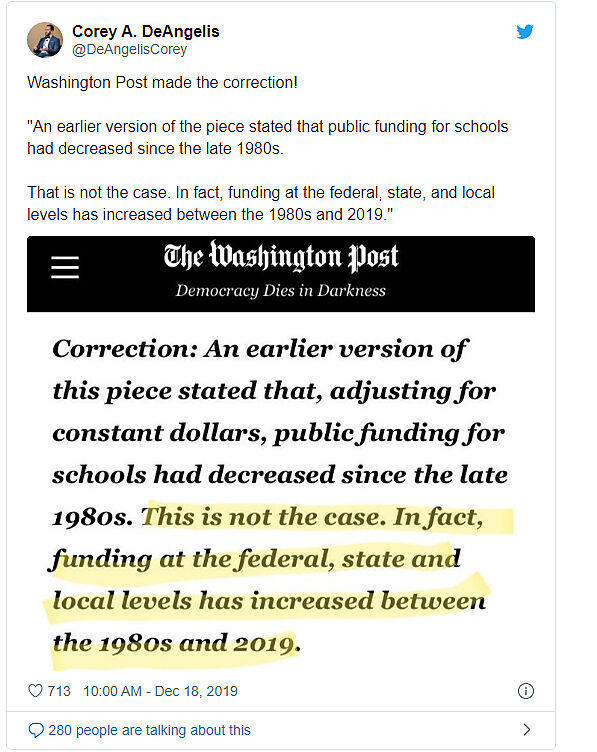They say that if you repeat a lie often enough, it will become the truth.
Several viral social media posts claim legislators have been draining education funding for years. A tweet from a high school football coach asserting that “they’ve been defunding education for years” has garnered over a half-million likes in just a few days.
The problem is that we haven’t actually defunded education. We’ve done the opposite.
On average, the United States currently spends over $15,000 per student each year, and inflation-adjusted K‑12 education spending per student has increased by 280% since 1960. In California, where the previously mentioned football coach resides, inflation-adjusted spending on K‑12 education has increased by 129% since 1970. Furthermore, data from the U.S. Census Bureau show that nearly a third of all state budget expenditures go toward education.
This is a particularly pernicious myth in the education debate because increased education spending generally isn’t associated with better results. Stanford University economist Eric Hanushek reviewed nearly 400 studies on the topic and concluded that “there is not a strong or consistent relationship between student performance and school resources.”
That shouldn’t surprise anyone. Pouring more money into the same broken system won’t fix the deeper problem — government monopolies have weak incentives to cater to the needs of their customers by spending money wisely.
Why won’t this myth ever die? And why do defenders of the government schooling monopoly fight so hard against legitimate data showing that we’ve clearly increased education funding substantially over time?
Part of the problem might have to do with media outlets often getting the basic facts wrong. False claims around education spending often go uncorrected, and corrections are likely to go unnoticed, especially when outlets drag their feet or make stealth edits.
For example, Robert Pianta, the dean of the Curry School of Education at the University of Virginia, authored a piece for the Washington Post falsely claiming that “public funding for schools has actually decreased since the late 1980s.” With prodding and evidence to the contrary, a correction was made to the article — but it was eight days after the article was published.

A couple of months later, the Philadelphia Inquirer similarly claimed that there have been “drastic cuts to funding over the last few decades” in education. That’s not true in the U.S. It’s not true in Pennsylvania either. The outlet eventually corrected the statement to say funding has actually increased, but that didn’t stop them from sticking to the same narrative.
In April, an article in the Washington Post falsely claimed that “education funding remained below pre-recession levels in real dollar terms in most states — sometimes up to 30 percent.” Its own source even showed that the claim was false on two counts: Real education spending actually increased in most states, and no state decreased funding by 30%.
In May, an article in the New York Times falsely claimed that “a year of U.S. public education costs about $400 billion.” Its own source showed they were off by a long shot. The U.S. spends about $739 billion each year on K-12 education, about 85% higher than the original false claim.
Also last month,the Washington Post claimed that D.C. schools spend “$11,310 in base spending” per student. That’s extremely misleading. The most recent data from the U.S. Census Bureau show that the district spends over $31,000 per student each year. The city's mayor also just proposed to further increase the district’s education spending despite the expected economic downturn.
The false claims consistently purport that we spend less than we actually do. In that sense, it shouldn’t surprise us that so many people believe that we have “been defunding education for years.” And if the public believes America spends less on education, they will be misled to push policymakers to throw more money at the problem without fixing real systemic issues.
One of the main issues with this approach is that too few dollars actually make it into the classroom.
Benjamin Scafidi's seminal report, Back to the Staffing Surge, outlines that the problem with K-12 education funding in America today isn’t the overall amount of dollars going into government schools, but how those dollars are allocated by school districts. Surges in staffing and administrative bloat have become the norm across the country. From 1950 to 2009, student populations increased by 96%, while non-teaching staff increased by a whopping 702%.
More recently, Scafidi observed that between 1992 and 2014, real education spending per pupil increased by 27%, whereas real teacher salaries dropped by 2%.
What makes defenders of the government schooling monopoly think that the money will actually make it into the classroom this time around? How can we change the system so that education dollars are spent wisely? How can we ensure that the money will be used to help students?
These are the kinds of discussions we should be having. There’s a lot of room to debate the costs and benefits of pouring more money into the current education system. But these discussions must be based on an agreed-upon set of basic facts rather than emotions.